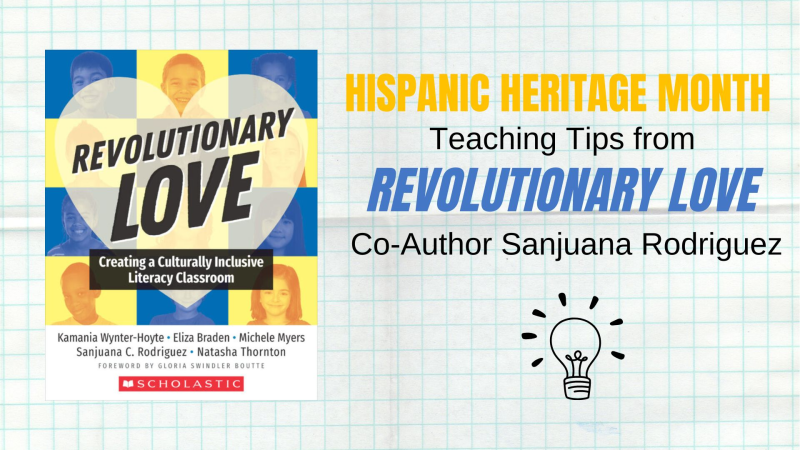In this post, Sanjuana Rodriguez refers to Hispanic Heritage Month as Hispanic/Latinx Heritage Month to acknowledge the growing shift of inclusivity within the culture.
Hispanic/Latinx Heritage Month is not only a special time to celebrate the culture and traditions of Latinx members, it’s a wonderful opportunity to share Hispanic/Latinx history and achievements with the rest of the world! Below, Revolutionary Love co-author Sanjuana Rodriguez shares a few tips for educators on how to enrich the classroom while teaching Hispanic/Latinx Heritage Month.
Why is it important to celebrate and call attention to Hispanic Heritage Month?
This month gives teachers an opportunity to engage students in discussions and activities that are focused on celebrating Hispanic/Latinx individuals and stories. We encourage teachers to get to know their Hispanic/Latinx student community and the backgrounds that are represented in their classrooms. It is important to understand what country they are from, which languages they speak, and any specific traditions they practice. These are great starting points to ensure what you teach in the classroom recognizes your students’ cultural backgrounds. It’s also important to celebrate their Heritage so that all students can learn about the rich history and achievements of the Hispanic/Latinx community.
How can educators encourage community-building practices during this time?
This is a great question! It is wonderful to involve community building practices and that often starts with your students’ own families. Parents and caregivers can be invited into your classroom, to share their knowledge, traditions and cultural practices with students. What they choose to share is up to them but anything related to the history and significance of their cultural traditions is a great place to start. Telling a family story or involving the class with an activity is fun way to engage students.
Sharing an oral history through student interviews of family and community members is a community building practice that will help students learn about their lives, cultures, and traditions. In class, work with students to come up with interview questions and help them practice their interviewing skills. After students have conducted their interviews, organize a special celebration where you might invite family and community members to see how the project came to fruition.
What are a few instructional tactics teachers should avoid?
We encourage teachers to move beyond a tourist perspective of culture: Avoid focusing on food or holidays only. While both are important to all cultures, neither provide the opportunity to really learn from or about families’ cultural experiences. Instead, invite students’ family or community members into the classroom to share how certain foods are sourced or how they celebrate certain holidays. These oral stories can become a way to invite families to share their knowledge with the class, and ultimately encourage meaningful and authentic learning.
How can teachers build an environment of cultural curiosity during Hispanic Heritage Month?
Storytelling is a powerful way to illuminate the traditions of our students, while still celebrating the love and joy present in their lives. Engaging in storytelling allows all students to learn about each other’s lives and experiences. The same holds true for children’s literature and art. Sharing stories and contemporary art created by Hispanic/Latinx individuals can engage students and prompt them to dive deeper into learning about the diverse experiences within the Hispanic/Latinx community.
What kind of resources can teachers utilize while teaching Hispanic Heritage Month?
When choosing texts for your classroom, it is important to select and highlight books written by Hispanic/Latinx authors. These books represent the diversity within the Hispanic/Latinx community, including diversity in experiences and language. Children’s books are a valuable resource that have the potential to highlight and uplift Hispanic/Latinx characters and stories. Another important resource for teachers are the teaching and learning resources offered by the Smithsonian National Museum of the American Latino.
It is also important to select texts that reflect children’s language and cultural practices. This might mean choosing texts that include translanguaging, or the representation of multiple languages in the story in a way that reflects the everyday speech and communication practices of students and families. Book awards such as the Pura Belpré, Tomás Rivera Book Award, and the Américas awards are great starting points for finding high-quality literature.
To keep up with Sanjuana Rodriguez, follow her on Twitter at @S_Rodriguez12 and be sure to follow @ScholasticEd for all things professional.
To learn more about Revolutionary Love, follow this hashtag #RevolutionaryLoveBook and find these authors on Facebook: Sanjuana C. Rodriguez, Michele Myers, Kamania Wynter-Hoyte, Eliza G. Braden, Natasha Thornton



